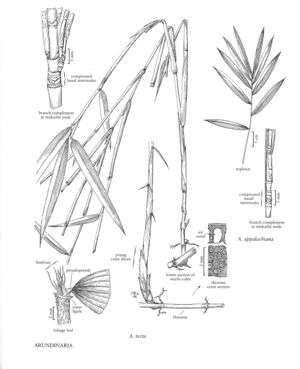Difference between revisions of "Arundinaria tecta"
FNA>Volume Importer |
imported>Volume Importer |
||
| (8 intermediate revisions by 2 users not shown) | |||
| Line 3: | Line 3: | ||
|accepted_authority=(Walter) Muhl. | |accepted_authority=(Walter) Muhl. | ||
|publications= | |publications= | ||
| + | |special_status={{Treatment/ID/Special_status | ||
| + | |code=E | ||
| + | |label=Endemic | ||
| + | }} | ||
|basionyms= | |basionyms= | ||
|synonyms={{Treatment/ID/Synonym | |synonyms={{Treatment/ID/Synonym | ||
|name=Arundinaria gigantea subsp. tecta | |name=Arundinaria gigantea subsp. tecta | ||
| − | |authority= | + | |authority= |
| + | |rank=subspecies | ||
}} | }} | ||
|hierarchy=Poaceae;Poaceae subfam. Bambusoideae;Poaceae tribe Bambuseae;Arundinaria;Arundinaria tecta | |hierarchy=Poaceae;Poaceae subfam. Bambusoideae;Poaceae tribe Bambuseae;Arundinaria;Arundinaria tecta | ||
| Line 19: | Line 24: | ||
-->{{Treatment/Body | -->{{Treatment/Body | ||
|distribution=Md.;N.J.;Okla.;Ala.;Ark.;Fla.;Ga.;La.;Miss.;N.C.;N.Y.;Pa.;S.C.;Tex.;Va.;Tenn. | |distribution=Md.;N.J.;Okla.;Ala.;Ark.;Fla.;Ga.;La.;Miss.;N.C.;N.Y.;Pa.;S.C.;Tex.;Va.;Tenn. | ||
| − | |discussion=<p>Arundinaria tecta grows in swampy woods, moist pine barrens, live oak woods, and along the sandy margins of streams, preferring moister sites than A. gigantea. It grows only on the coastal plain of the southeastern United States.</p> | + | |discussion=<p><i>Arundinaria tecta</i> grows in swampy woods, moist pine barrens, live oak woods, and along the sandy margins of streams, preferring moister sites than <i>A. gigantea</i>. It grows only on the coastal plain of the southeastern United States.</p> |
|tables= | |tables= | ||
|references= | |references= | ||
| Line 28: | Line 33: | ||
-->{{#Taxon: | -->{{#Taxon: | ||
name=Arundinaria tecta | name=Arundinaria tecta | ||
| − | |||
|authority=(Walter) Muhl. | |authority=(Walter) Muhl. | ||
|rank=species | |rank=species | ||
| Line 35: | Line 39: | ||
|basionyms= | |basionyms= | ||
|family=Poaceae | |family=Poaceae | ||
| + | |illustrator=Cindy Roché;Annaliese Miller | ||
| + | |illustration copyright=Utah State University | ||
|distribution=Md.;N.J.;Okla.;Ala.;Ark.;Fla.;Ga.;La.;Miss.;N.C.;N.Y.;Pa.;S.C.;Tex.;Va.;Tenn. | |distribution=Md.;N.J.;Okla.;Ala.;Ark.;Fla.;Ga.;La.;Miss.;N.C.;N.Y.;Pa.;S.C.;Tex.;Va.;Tenn. | ||
|reference=None | |reference=None | ||
|publication title= | |publication title= | ||
|publication year= | |publication year= | ||
| − | |special status= | + | |special status=Endemic |
| − | |source xml=https:// | + | |source xml=https://bitbucket.org/aafc-mbb/fna-data-curation/src/200273ad09963decb8fc72550212de541d86569d/coarse_grained_fna_xml/V24/V24_11.xml |
|subfamily=Poaceae subfam. Bambusoideae | |subfamily=Poaceae subfam. Bambusoideae | ||
|tribe=Poaceae tribe Bambuseae | |tribe=Poaceae tribe Bambuseae | ||
Latest revision as of 16:21, 11 May 2021
Rhizomes normally horizontal for only a short distance before turning up to form a culm, hollow-centered, air canals present. Culms usually shorter than 2.5 m tall, to 2 cm thick; internodes terete in the vegetative parts. Culm leaves persistent to tardily deciduous; sheaths 11-18 cm; fimbriae 1.5-8.5 mm; blades 2.5-4 cm. Topknots of 9-12 leaves; blades 20-30 cm long, 1.8-3.2 cm wide, lanceolate to ovate-lanceolate. Primary branches usually 50+ cm, basally erect and distally arcuate, terete, with 3-4 compressed basal internodes, basal nodes developing secondary branches, lower elongated internodes terete in cross section. Foliage leaves: abaxial ligules fimbriate to lacerate, sometimes ciliate; blades 7-23 cm long, 1-2 cm wide, coriaceous, persistent, evergreen, bases rounded, abaxial surfaces densely pubescent or glabrous, strongly cross veined, adaxial surfaces pubescent. Spikelets 3-5 cm, with 6-12 florets, the first occasionally sterile. Glumes unequal, glabrous or pubescent; lowest glume obtuse to acuminate or absent; lemmas 1.2-2 cm, glabrous or nearly so. Caryopses oblong, beaked, a rudimentary hooked style branch present below the beak. 2n = unknown.
Distribution
Md., N.J., Okla., Ala., Ark., Fla., Ga., La., Miss., N.C., N.Y., Pa., S.C., Tex., Va., Tenn.
Discussion
Arundinaria tecta grows in swampy woods, moist pine barrens, live oak woods, and along the sandy margins of streams, preferring moister sites than A. gigantea. It grows only on the coastal plain of the southeastern United States.
Selected References
None.
